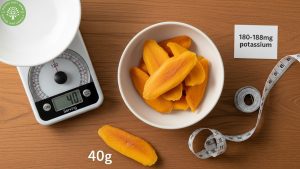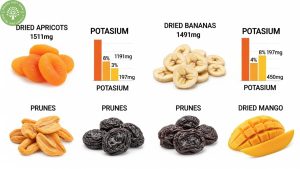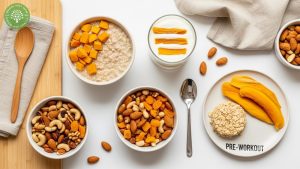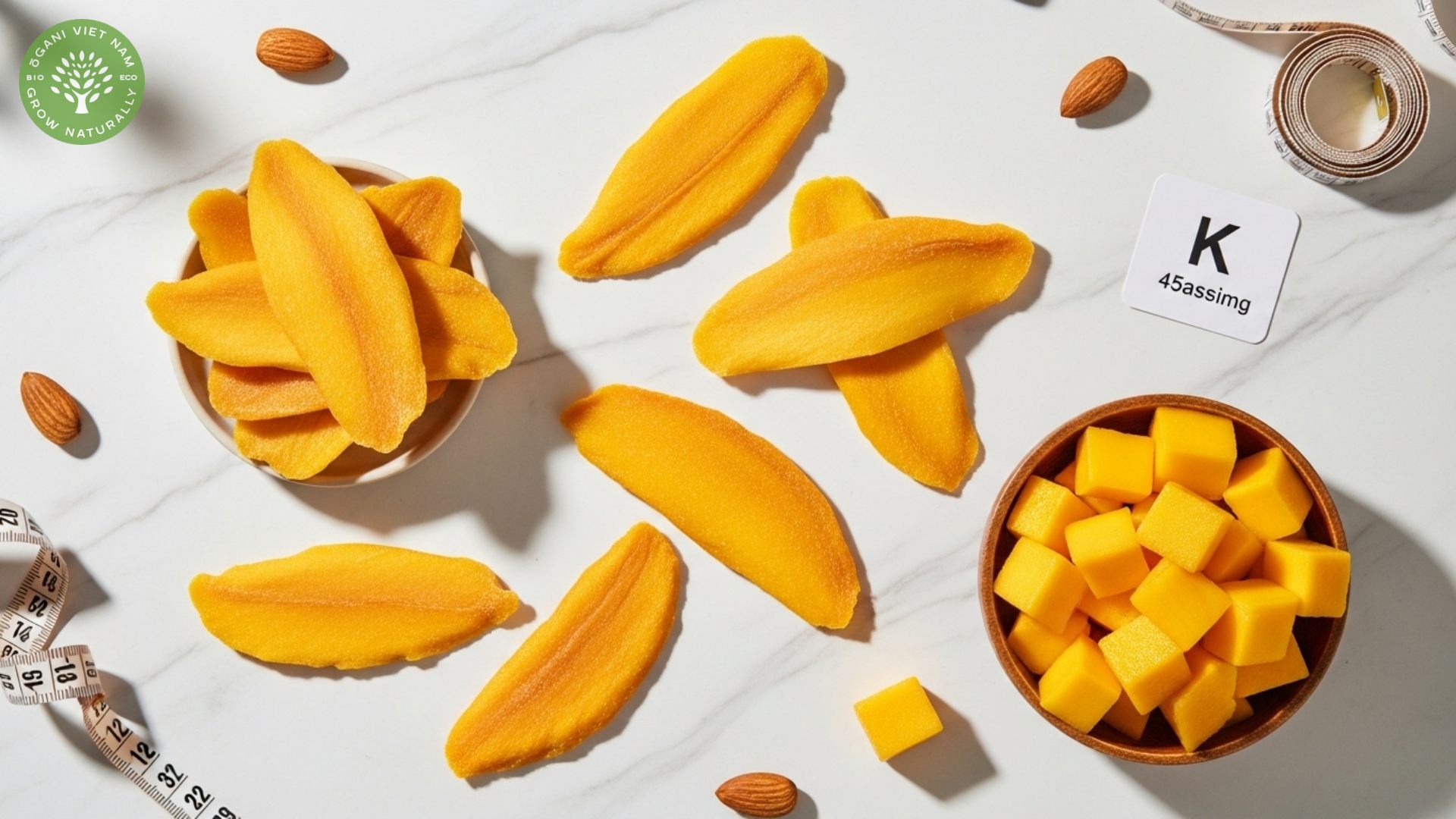When you’re looking for potassium in dried mango, you’ll find approximately 450mg per 100g serving—that’s about 10% of your daily recommended intake. This makes dried mango a solid potassium source, though not quite as concentrated as dried apricots or bananas.
How much potassium in dried mango you actually get

The dehydration process actually concentrates nutrients in mangoes, making dried versions more potassium-dense than fresh ones. A single fresh mango contains roughly 323mg of potassium, but when you remove the water content, that same amount of fruit yields significantly higher potassium levels per gram.
Here’s what you need to know: a typical 40g serving of dried mango (about a small handful) delivers around 180-188mg of potassium. That might not sound like much compared to other dried fruits, but it’s enough to contribute meaningfully to your daily intake—especially when you consider how portable and shelf-stable this snack is.
At Ogani VN, we’ve noticed customers often underestimate dried mango’s nutritional profile. They think of it purely as a sweet treat, not realizing it’s actually packing essential minerals like potassium alongside vitamins A, C, and E. The real question isn’t whether dried mango contains potassium—it absolutely does—but whether it fits your specific dietary needs.
Why potassium matters for your body

Potassium is one of those minerals your body can’t produce on its own, yet it’s involved in nearly every critical function. Your heart relies on it to maintain steady rhythm. Your muscles need it to contract properly. Even your nervous system depends on potassium to transmit signals between cells.
Most adults need around 2,600-3,400mg of potassium daily, according to current dietary guidelines. Unfortunately, the average person falls short. We’re usually pretty good about getting enough sodium—maybe too good—but potassium? That’s where things get tricky.
This is where dried fruits like mango come in handy. They’re not a magic solution, but they’re a practical one. You can toss a bag in your gym backpack, keep some at your desk, or pack it for long flights when fresh fruit isn’t available. The potassium stays stable, the flavor holds up, and you’re actually getting nutritional value instead of empty calories from processed snacks.
The blood pressure connection
The relationship between potassium and blood pressure is particularly interesting. When you consume adequate potassium, it helps your kidneys flush out excess sodium—the stuff that makes your blood pressure climb. It’s like having a natural counterbalance system. Dried mango won’t replace your blood pressure medication, obviously, but as part of a balanced diet? It’s definitely pulling its weight.
Potassium in dried mango vs other dried fruits

Let’s be honest here—dried mango isn’t the heavyweight champion of potassium-rich foods. Dried apricots blow it out of the water with 1,511mg per 100g. Dried bananas come in around 1,491mg. Even prunes clock in at 1,397mg.
So why even bother with dried mango if other fruits have more potassium? Because nutrition isn’t just about cramming in the highest numbers possible. It’s about what you’ll actually eat consistently.
Here’s a comparison table to put things in perspective:
| Food Item | Potassium (per 100g) | % Daily Value |
|---|---|---|
| Dried Apricots | 1,511mg | 32% |
| Dried Bananas | 1,491mg | 32% |
| Prunes | 1,397mg | 30% |
| Dried Mango | 450mg | 10% |
| Fresh Mango | 168mg | 4% |
Why dried mango still wins for many people
Some people can’t stand the texture of dried apricots. Others find prunes too… well, effective for their digestive system. Dried mango has a chewy, candy-like quality that makes it feel more like an indulgence than a health food. That psychological difference matters when you’re trying to maintain healthy eating habits long-term.
Plus, dried mango brings other nutrients to the table. You’re getting vitamin C (around 16-19% DV), fiber, and beta-carotene alongside that potassium. It’s not a one-trick pony.
Fresh vs dried mango for potassium
Fresh mango contains significantly less potassium—only about 168mg per 100g compared to 450mg in dried form. That’s nearly three times less. If you’re specifically targeting potassium intake, the dried version gives you more bang for your buck in terms of nutrients per bite.
Complete nutritional profile of potassium in dried mango
People search for potassium in dried mango because they care about that specific mineral, but honestly? You’re shortchanging yourself if that’s all you pay attention to.
A standard 40g serving of dried mango contains roughly 128 calories, 31g of carbohydrates, 1g of fiber, and 1g of protein. The vitamin C content is surprisingly high for a dried fruit—many drying processes destroy vitamin C, but mango retains a decent amount. You’re also getting flavonoid antioxidants, small amounts of iron and calcium, and vitamins A, E, and B6.
The sugar situation you need to know
The elephant in the room is sugar content. That same 40g serving packs about 27g of sugar. Some of that is natural fruit sugar, but many commercial brands add extra sweetness. At Ogani VN, we always recommend checking the ingredient list. If it just says “mango” or “mango, sulfur dioxide” (a preservative), you’re good. If you see “sugar,” “cane syrup,” or “honey” added, that’s when the sugar content starts getting problematic.
Does the high sugar content cancel out the potassium in dried mango benefits? Not necessarily—but it does mean dried mango works best as an occasional snack rather than something you eat by the handful every day. Think of it as a nutrient-dense treat, not a free-for-all health food. The key is balancing the natural sugars with the mineral benefits you’re getting. If you’re specifically eating dried mango for its potassium in dried mango content, portion control becomes even more important to avoid blood sugar spikes while still getting those essential minerals.
Beyond potassium: other minerals and vitamins
The fiber content is disappointingly low compared to fresh mango. Most of that fiber gets concentrated in the drying process, but 1g per serving still isn’t much. You’re not going to fix constipation with dried mango alone. But combined with other fiber sources throughout your day, every little bit adds up.
The beta-carotene (which converts to vitamin A) in dried mango supports eye health and immune function. The vitamin E acts as an antioxidant, protecting your cells from damage. And those flavonoid compounds? They have anti-inflammatory properties that benefit your whole body. While people often focus solely on potassium in dried mango, these additional nutrients work synergistically to support overall health—making it more than just a one-dimensional snack. When you choose quality dried mango, you’re not just getting a single mineral boost; you’re investing in a complete package of micronutrients that complement the potassium content perfectly.
Best ways to maximize potassium in dried mango benefits

The difference between dried mango being a healthy addition versus a sugar bomb comes down to how you use it. Eating an entire bag while binge-watching Netflix? That’s dessert, not nutrition.
Try these approaches instead:
Morning boost strategy
Chop 2-3 pieces of dried mango into your oatmeal or yogurt. The natural sweetness means you can skip added sugar, and you’re distributing that potassium throughout your breakfast instead of loading up on one nutrient source.
Pre-workout fuel timing
About 30-45 minutes before exercising, eat a small handful (20-30g) of dried mango. The quick-digesting carbs give you energy, and the potassium helps prevent muscle cramps during longer workouts. We’ve had multiple customers tell us this timing works better than bananas for their training sessions.
Trail mix for sustained energy
Mix dried mango with nuts, seeds, and maybe some dark chocolate chips. The fat and protein from nuts slow down sugar absorption, giving you more sustained energy. Plus, the combination creates a more complete nutrient profile—you’re getting potassium from the mango, magnesium from the nuts, and healthy fats to keep you satisfied.
Creative salad additions
This sounds weird until you try it. Dice dried mango small and scatter it over green salads with a tangy vinaigrette. The sweet-tart contrast is incredible, and you’re sneaking extra nutrients into a meal that’s already pretty healthy.
Portion control that works
Pre-portion your dried mango into small containers or bags—about 30-40g each. When you keep the whole bag accessible, it’s way too easy to mindlessly eat three or four servings. Having pre-measured portions removes that temptation while still letting you enjoy the snack.
One thing we tell customers at Ogani VN: if you’re specifically trying to increase potassium intake for health reasons (managing blood pressure, reducing muscle cramps, supporting heart health), don’t rely solely on dried mango. Combine it with other potassium sources like avocados, sweet potatoes, white beans, and leafy greens. Variety matters more than any single food.
Frequently Asked Questions
Is potassium in dried mango better than fresh mango?
Yes, dried mango contains more potassium per gram because the water has been removed, concentrating the nutrients. However, fresh mango is lower in sugar and calories, so each has its place in a balanced diet.
How much dried mango should I eat daily for potassium benefits?
A 40-50g serving (about 10-12 pieces) provides roughly 180-225mg of potassium, which is about 4-5% of your daily needs. This is a reasonable portion that gives you nutritional benefits without excessive sugar intake.
Does the drying process destroy potassium in mango?
No, potassium is a mineral that remains stable during dehydration. Unlike some vitamins that degrade with heat or air exposure, the potassium content actually becomes more concentrated as water evaporates.
Can diabetics eat dried mango for its potassium?
People with diabetes should be cautious with dried mango due to its concentrated sugar content. If you choose to eat it, stick to very small portions (15-20g), pair it with protein or healthy fats to slow sugar absorption, and monitor your blood glucose response.
Is organic dried mango higher in potassium?
Not necessarily. The potassium content depends more on the mango variety and ripeness at harvest than whether it’s organic or conventional. However, organic options typically have fewer additives and no sulfur dioxide preservatives.
Conclusion
Potassium in dried mango isn’t going to single-handedly meet your daily mineral needs, but it’s a legitimate contributor when you’re strategic about portions. With 450mg per 100g, dried mango sits comfortably in the middle range of potassium-rich foods—not the absolute best, but far from nutritionally empty.
The real value comes from consistency and smart pairing. Use dried mango as one tool in your nutritional toolkit, not the only one. Combine it with other whole foods, watch your portion sizes to manage sugar intake, and enjoy the fact that you’re getting genuine nutrition from something that tastes like candy.
At Ogani VN, we’re committed to helping you make informed choices about dried fruits and healthy snacking. Whether you’re an athlete looking to prevent cramping, someone managing blood pressure, or just trying to eat a bit healthier without sacrificing taste, dried mango deserves a spot in your pantry. Browse our selection of premium dried mango—naturally sweet, no added sugars, and packed with the minerals your body actually needs. Your future self (and your taste buds) will thank you.


